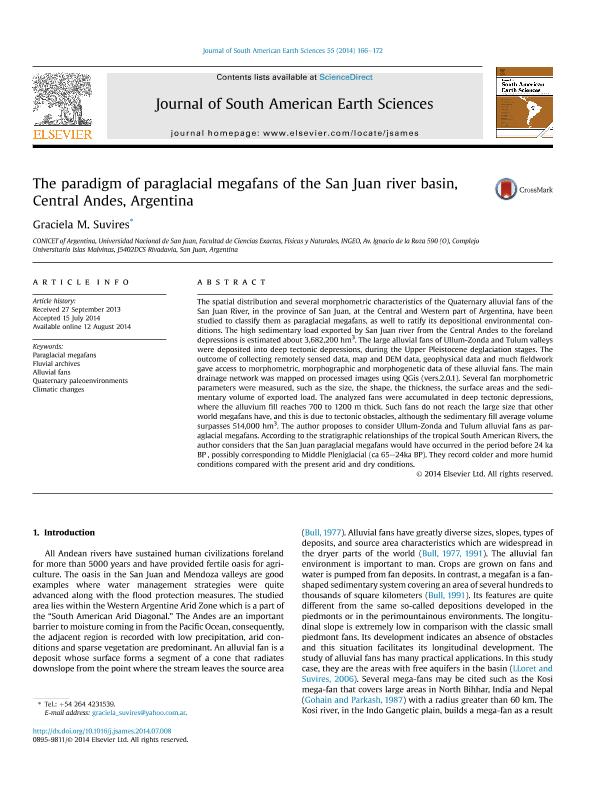Mostrar el registro sencillo del ítem
dc.contributor.author
Suvires, Graciela Mabel

dc.date.available
2016-03-23T15:00:07Z
dc.date.issued
2014-08
dc.identifier.citation
Suvires, Graciela Mabel; The paradigm of paraglacial megafans of the San Juan river basin, Central Andes, Argentina; Elsevier; Journal Of South American Earth Sciences; 55; 8-2014; 166-172
dc.identifier.issn
0895-9811
dc.identifier.uri
http://hdl.handle.net/11336/4915
dc.description.abstract
The spatial distribution and several morphometric characteristics of the Quaternary alluvial fans of the San Juan River, in the province of San Juan, at the Central and Western part of Argentina, have been studied to classify them as paraglacial megafans, as well to ratify its depositional environmental conditions. The high sedimentary load exported by San Juan river from the Central Andes to the foreland depressions is estimated about 3,682,200 hm3. The large alluvial fans of Ullum-Zonda and Tulum valleys were deposited into deep tectonic depressions, during the Upper Pleistocene deglaciation stages. The outcome of collecting remotely sensed data, map and DEM data, geophysical data and much fieldwork gave access to morphometric, morphographic and morphogenetic data of these alluvial fans. The main drainage network was mapped on processed images using QGis (vers.2.0.1). Several fan morphometric parameters were measured, such as the size, the shape, the thickness, the surface areas and the sedimentary volume of exported load. The analyzed fans were accumulated in deep tectonic depressions, where the alluvium fill reaches 700 to 1200 m thick. Such fans do not reach the large size that other world megafans have, and this is due to tectonic obstacles, although the sedimentary fill average volume surpasses 514,000 hm3. The author proposes to consider Ullum-Zonda and Tulum alluvial fans as paraglacial megafans. According to the stratigraphic relationships of the tropical South American Rivers, the author considers that the San Juan paraglacial megafans would have occurred in the period before 24 ka BP , possibly corresponding to Middle Pleniglacial (ca 65-24ka BP). They record colder and more humid conditions compared with the present arid and dry conditions.
dc.format
application/pdf
dc.language.iso
eng
dc.publisher
Elsevier

dc.rights
info:eu-repo/semantics/openAccess
dc.rights.uri
https://creativecommons.org/licenses/by-nc-nd/2.5/ar/
dc.subject
Archivos Fluviales
dc.subject
Megaformas
dc.subject
Paraglacial Megafans
dc.subject
Middle Pleniglacial Palaeoreliefs
dc.subject.classification
Geología

dc.subject.classification
Ciencias de la Tierra y relacionadas con el Medio Ambiente

dc.subject.classification
CIENCIAS NATURALES Y EXACTAS

dc.title
The paradigm of paraglacial megafans of the San Juan river basin, Central Andes, Argentina
dc.type
info:eu-repo/semantics/article
dc.type
info:ar-repo/semantics/artículo
dc.type
info:eu-repo/semantics/publishedVersion
dc.date.updated
2016-03-30 10:35:44.97925-03
dc.journal.volume
55
dc.journal.pagination
166-172
dc.journal.pais
Países Bajos

dc.journal.ciudad
Amsterdam
dc.description.fil
Fil: Suvires, Graciela Mabel. Consejo Nacional de Investigaciones Científicas y Técnicas. Centro Científico Tecnológico San Juan. Centro de Investigaciones de la Geosfera y Biosfera; Argentina. Universidad Nacional de San Juan. Facultad de Ciencias Exactas, Fisicas y Naturales. Instituto de Geologia "Dr. Emiliano Aparicio"; Argentina
dc.journal.title
Journal Of South American Earth Sciences

dc.relation.alternativeid
info:eu-repo/semantics/altIdentifier/ark/http://www.sciencedirect.com/science/article/pii/S089598111400090X
dc.relation.alternativeid
info:eu-repo/semantics/altIdentifier/doi/http://dx.doi.org/10.1016/j.jsames.2014.07.008
dc.relation.alternativeid
info:eu-repo/semantics/altIdentifier/doi/10.1016/j.jsames.2014.07.008
Archivos asociados
